What is the “Online Dictionaries and Full-text Search of Mongolian Languages and Written Manchu”?
The Online Dictionaries and Full-text Search of Mongolian Languages and Written Manchu モンゴル諸語と満洲語の資料検索システム (Mongoru shogo to Manshūgo no shiryō kensaku shisutemu) is an online database of digitalized dictionaries and texts for Inner and East Asian languages. It was created by Dr. Hitoshi Kuribayashi (栗林均) and his team at the Center for Northeast Asian Studies (東北アジア研究センター) of the Tohoku University in Japan. The database has been online since 2017.
The open-access online database contains two types of digitalized texts: dictionaries and scanned texts. At the moment, there are in total thirty-nine dictionaries featuring various Northeast Asian languages in the database. In addition to the twenty-one dictionaries that contain translations of the Mongolian language (in both the classical and the Cyrillic script) into various Asian and European languages, the database also contains ten dictionaries that translate Manchu, and eleven dictionaries that translate various other Mongolic languages (Oirat [Clear script], Dagur, Monguor, Dongxian [Santa], and Bonan).
The scanned texts in the database are full-text searchable. It includes two Mongolian texts written in Chinese transcription (Yuan chao mi shi 元朝秘史, Hua yi yi yu 華夷譯語); three texts written in Mongolian, Manchu, and Chinese (Yu zhi man meng wen jian 御製滿蒙文鑑, Man zhou shi lu 滿洲實錄, Xiao jing 孝經); and four Manchu texts with Japanese translations (Qing wen qi meng 清文啟蒙, Ni shan sa man [Nišan saman i bithe] 尼山薩滿, Lao qi da [Nogeoldae] 老乞大 , Yi bai tiao [Tanggū meyen] 一百條).
Although the rich content and diverse functions of Dr. Kuribayashi’s database deserve more detailed descriptions, for the sake of brevity, this short introduction will only focus on explaining the digitalized dictionaries for Mongolian language study and research.
How do you use the Online Dictionaries?
Translating from Mongolian
The most powerful function of Dr. Kuribayashi’s database is the ability to allow users to look up Mongolian words and get results in a wide range of languages (Mongolian, Manchu, Chinese, Japanese, English, French, Tibetan, and Chagatai). For input, the database accepts keywords typed in Romanized, classical, and Cyrillic script. Mongolian words in part or in whole can be used as keywords for searches. Installing keyboards that support typing in the Mongolian scripts is not necessary, since Roman letters directly typed into the search bar can be automatically turned into the appropriate script once the option is selected (Fig. 1). Various keyboards are available for download in the database if users find them necessary.

Fig.1a Words typed into the search bar will automatically be turned into the Cyrillic script when “見出し語” is selected.

Fig. 1b If “文語” is selected, words typed into the search bar will be automatically turned into the classical script.
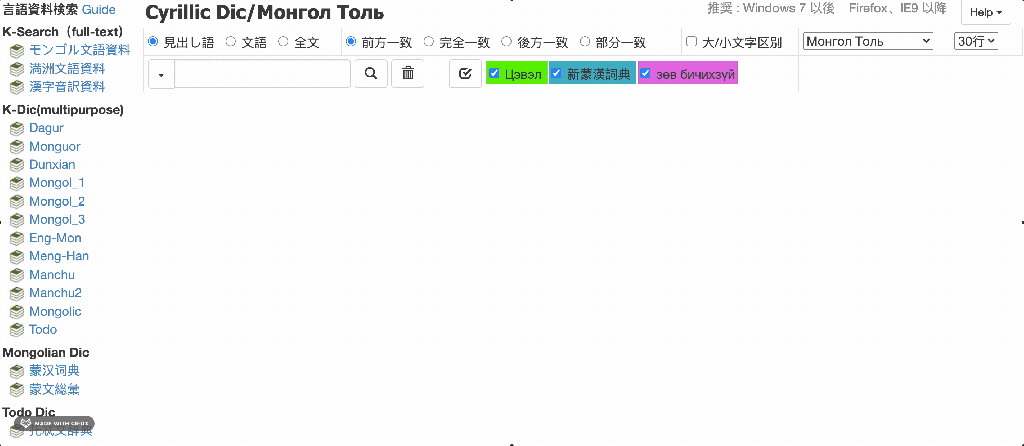
Fig. 1c When “全文” is selected, users can type Romanized words into the search bar.
The results of keyword searches vary with different dictionary groups. “K-Dic (multipurpose)/Mongol_1” features six historical multilingual dictionaries compiled between the 18th century to the first half of the 20th century (Wu ti qing wen jian 五體清文鑑, Meng wen dao gang 蒙文倒綱, Meng wen zong hui 蒙文總匯, Man meng wen jian 滿蒙文鑑, San he qie yin qing wen jian 三合切音清文鑑, and Meng han zi dian 蒙漢字典). Results from this group of dictionaries mostly contain Chinese, Manchu, and Japanese translations and definitions (Fig. 2).

Fig.2 The page for the dictionaries grouped under “Mongol_1.”
“Mongol_2” features two dictionaries that are useful for looking up how Mongolian was written and pronounced before the 18th century (Er shi yi juan ben ci dian 二十一卷本辭典) and how it compares to modern Mongolian today (Meng yu zheng yin zheng zi ci dian 蒙語正音正字詞典) (Fig. 3).

Fig. 3 The page for the dictionaries grouped under “Mongol_2.”
“Mongol_3” features three modern dictionaries that are useful for translating Mongolian into English (Lessing), Japanese (Mōkogo daijiten蒙古語大辞典), and French (Kowalewski). This group of dictionaries support keywords typed in Romanized, classical, and Cyrillic script (see Fig. 1 and Fig. 4).
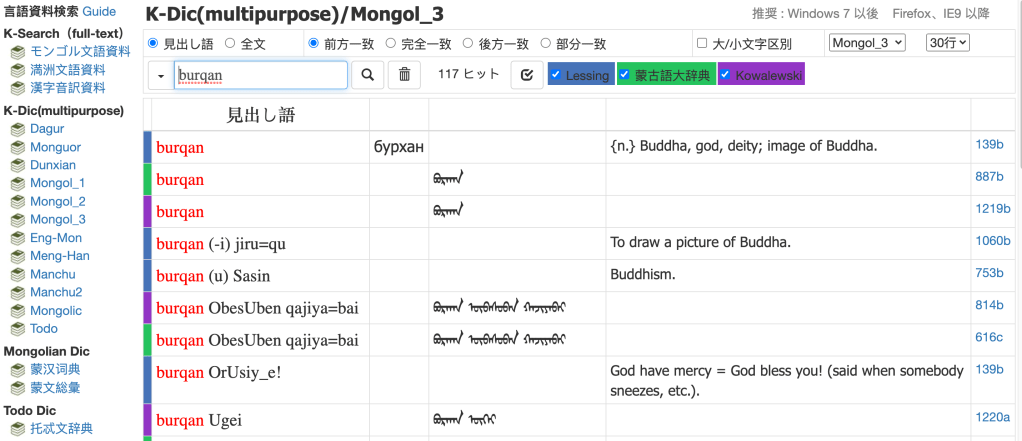
Fig. 4 The page for the dictionaries grouped under “Mongol_3.”
The two dictionaries grouped under the heading “Mongolian Dic” in the left-hand side menu are useful for looking up Mongolian words (in Romanized or classical script) in modern Chinese (Meng han ci dian 蒙漢詞典) (Fig. 5). The Qing-era Meng wen zong hui (蒙文總匯) dictionary provides Chinese and Manchu translations of the Mongolian terms as well as transliterations of those terms in Manchu (Fig.6).
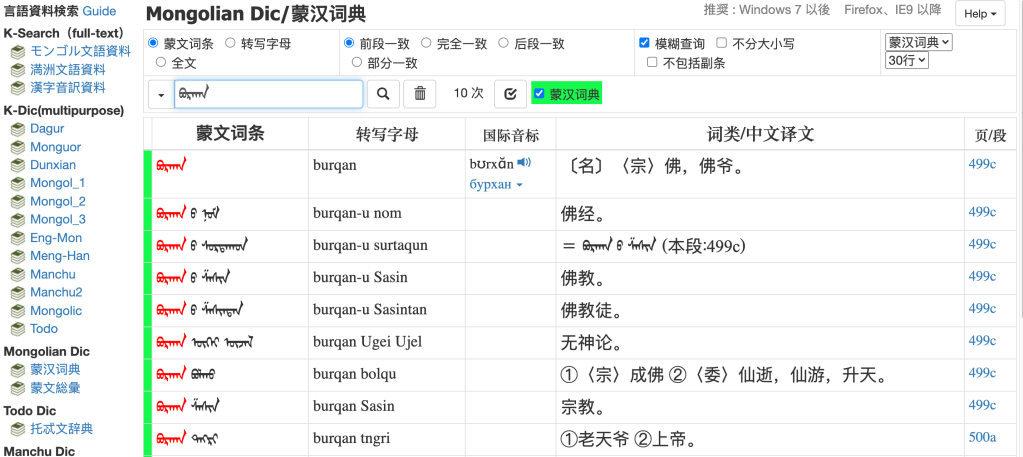
Fig. 5 The page for the Mongolian-Chinese dictionary grouped under “Mongolian Dic.”

Fig. 6 The page for the Mongolian-Manchu-Chinese dictionary grouped under “Mongolian Dic.”
For looking up Mongolian words in the Cyrillic script, the dictionaries grouped under the heading “Cyrillic Dic – Монгол Толь” are the most appropriate. Here, keywords can be typed in Romanized, classical, or Cyrillic scripts. Results also contain all three renditions as well as definitions in Cyrillic Mongolian (Tsevel Цэвэл) and modern Chinese (Xin meng han ci dian xin 新蒙漢詞典) (Fig. 7). For results in English and Japanese, users can select the “монгол-япон/англи” group (Fig. 8). For results in Russian, users can select the “монгол-орос” option (Fig. 9).
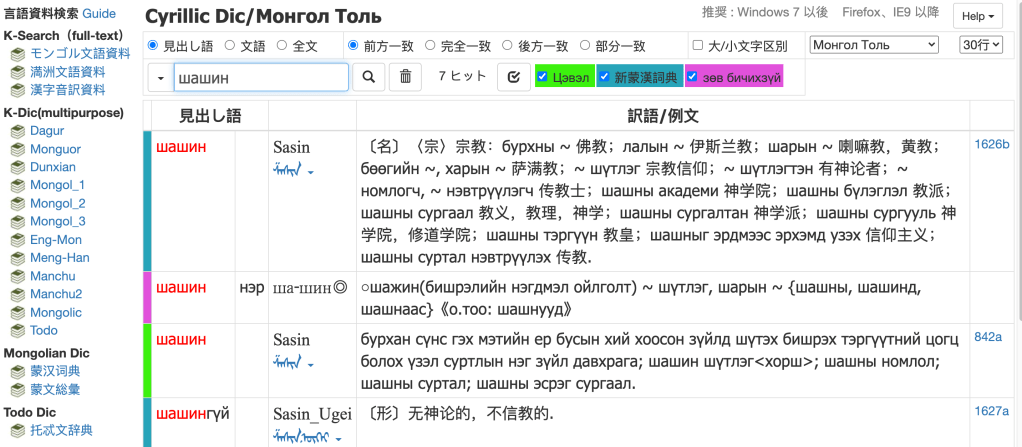
Fig. 7 The page for the Cyrillic Mongolian dictionaries grouped under “Cyrillic Dic – Монгол Толь.”
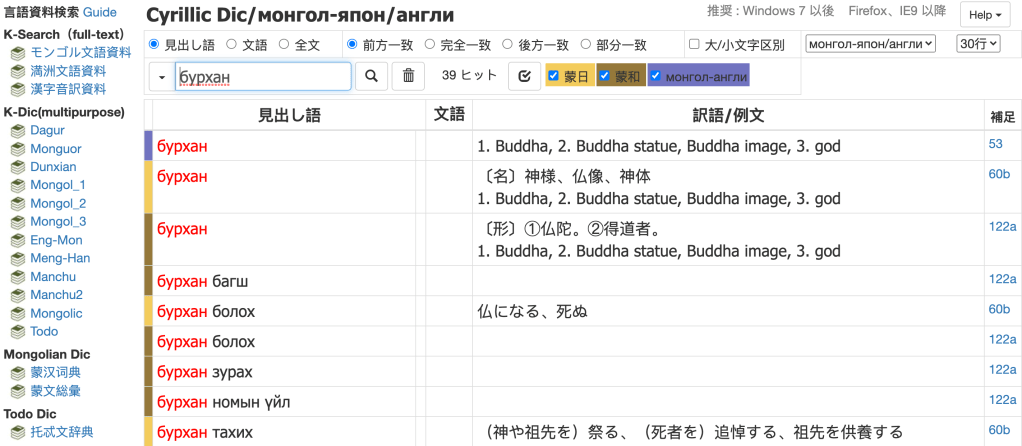
Fig. 8 The page for the Cyrillic Mongolian-Japanese and Cyrillic Mongolian-English dictionaries grouped under “Cyrillic Dic -монгол-япон/англи.”

Fig. 9 The page for the Cyrillic Mongolian-Russian dictionary grouped under “Cyrillic Dic – монгол-орос.”
Translating into Mongolian
Dr. Kuribayashi’s database of digitized Mongolian language resources also contain dictionaries for translations into Mongolian. “K-Dic (multipurpose) – Eng-Mon” allows users to search words in English for equivalents in Mongolian (Cyrillic only) (Fig. 10). “Japanese-Mongolian” (日・モ辞典) allows for words in modern Japanese to be translated into Mongolian (Cyrillic only) (Fig. 11). To translate Chinese words into Mongolian, many of the above-mentioned dictionaries do actually contain this function, albeit indirectly. By selecting “search all” (全文) when typing Chinese into the search bar, instances containing that term will show up in the results, allowing the user to find entries containing the Mongolian equivalent in both the classical and Cyrillic script (Fig. 12).
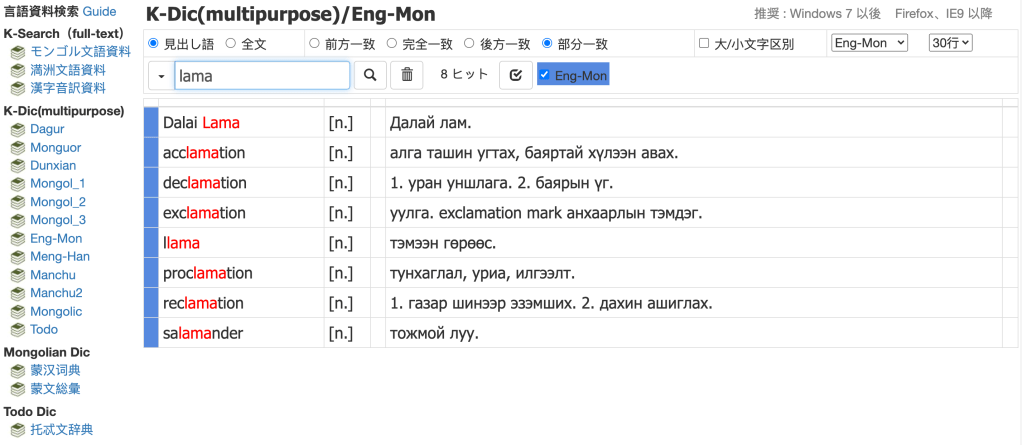
Fig. 10 The page for the English-Mongolian dictionary grouped under “K-Dic(multipurpose)/Eng-Mon.”
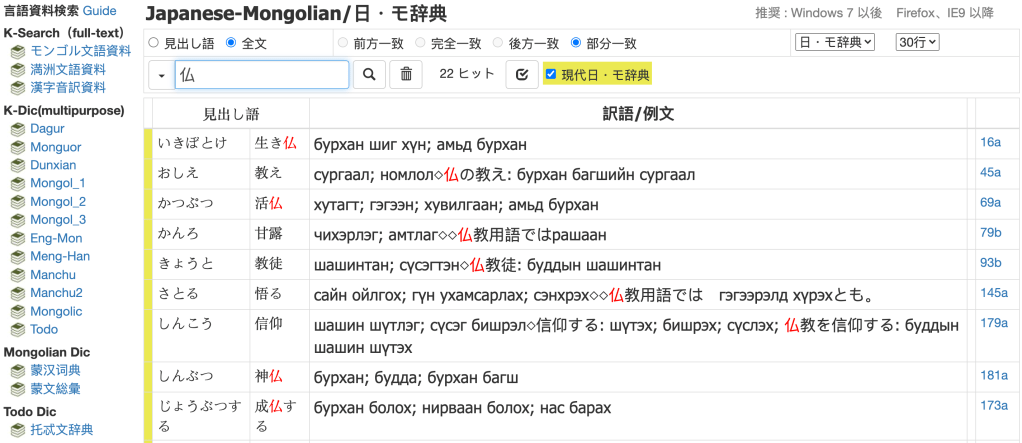
Fig. 11 The page for the Japanese-Mongolian dictionary grouped under “Japanese-Mongolian 日・モ辞典.”
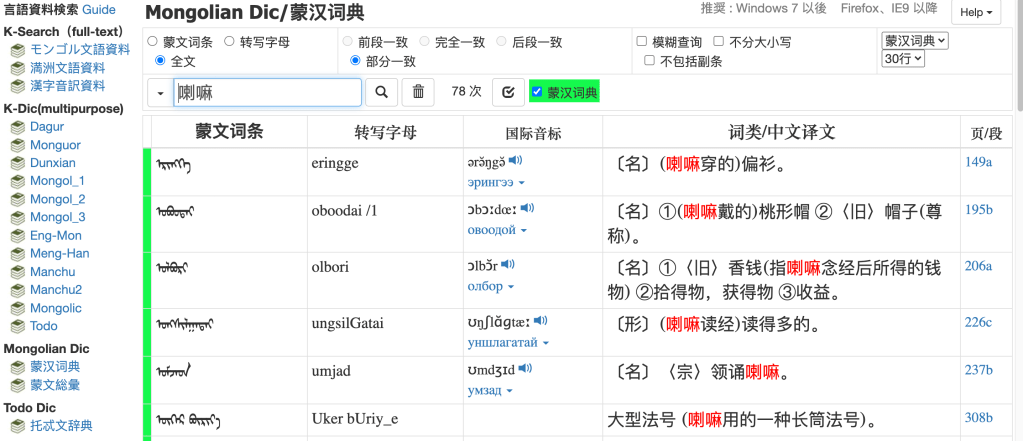
Fig. 12 Users can use the Mongolian-Chinese dictionary as a Chinese-Mongolian dictionary by typing keywords in Chinese and selecting “全文” (select all) before hitting the search button.
Hidden Functions: Cross-referencing Mongolian with Manchu, Chinese, Tibetan and Chagatai
A hidden but really useful function of this amazingly comprehensive digital database is the ability to cross-reference Mongolian words with its equivalents in Manchu, Tibetan, Chinese, and Chagatai all at the same time. This is possible through clicking “K-Dic (multipurpose)/Mongol_1” and selecting only the “Wu ti qing wen jian 五體清文鑑.” This particular dictionary is also known as the Manchu Polyglot Dictionary (Yuzhi Wuti Qing Wenjian 御製五體清文鑑). It contains translations of Manchu into the other four administrative languages of the Qing empire: Mongolian, Tibetan, Chinese, and Chagatai.
Results from a keyword search in this source should appear on the webpage in Chinese, Manchu (romanized), and Japanese only. However, if the user clicks on the numbered links in the columns on the right, a window will pop up showing a scanned page from the original Manchu Polyglot Dictionary containing the entered keyword (Fig. 13).
On the scanned page, the top row features the word entry in Manchu, followed by its translation in Tibetan. The next two rows contain the transliteration of the Tibetan word as well as the transcription of the Tibetan pronunciation in Manchu alphabets. The fifth row is the translation of the Manchu word in Mongolian, followed by its translation into Chagatai and the transcription of the Chagatai form in Manchu alphabets. The last row features the equivalent of the Manchu entry word in Chinese (Fig. 13).

Fig. 13 To access the pentaglot dictionary for cross-referencing between Manchu, Mongolian, Tibetan, Chinese, and Chagatai, select “五體清文鑑,” type in the wanted keyword, and click on the linked numbers on the right.
For Tibetan readers translating Mongolian, both the Mongolian-Japanese dictionary (Mōkogo daijiten蒙古語大辞典) and the Mongolian-French dictionary (Kowalewski) grouped under “Mongol_3” contain additional Tibetan translations for each of their entries. This hidden function is again only accessible through clicking on the numbered links on the right side of the web page. The new window will reveal similarly a scanned page of the original paper dictionaries containing the searched keyword (Fig. 14).

Fig. 14a The Mongolian-Japanese dictionary (蒙古語大辞典) also contains entries translated into Tibetan.

Fig. 14b The Kowalewski Mongolian-French dictionary contains entries translated into Tibetan as well.
Other Useful Functions
To check how a Mongolian word is pronounced, there is an audio option for entries in the Mongolian-Chinese dictionary (Meng han ci dian 蒙漢詞典) grouped under “Mongolian Dic” in the right-hand menu. If the user clicks on the Cyrillic, it can also take them to the Cyrillic Mongolian dictionaries (Fig. 15).

Fig. 15 The Mongolian-Chinese dictionary (蒙漢詞典) contains audio pronunciations of certain Mongolian words. Users can also jump between dictionaries for the same entry with the links provided.
To check how a Mongolian word is spelled in the classical script, the Mongolian-Japanese dictionary grouped under “Mongol_3” contains the spelling breakdown of all the entry words. Users can access this by clicking on the numbered links on the right (Fig. 16). This is a rare function often not found in Mongolian dictionaries, but can be extremely helpful for new learners of the language who find the classical script challenging.

Fig. 16 The Mongolian-Japanese dictionary (蒙古語大辞典) contains the breakdown of classical Mongolian spelling.
Who can benefit from this database?
This database is an indispensable resource for all scholars who work with texts in Inner Asian and East Asian languages. The database is particularly useful for scholars of Qing studies, since the database allows users to cross-reference lexemes in all of the Qing-era administrative languages, namely Manchu, Mongolian, Chinese, Tibetan, and Chagatai. Scholars of Mongolian studies and other Mongolic languages (Oirat, Dagur, Monguor, Dongxian [Santa], Bonan) and cultures will also find this database an invaluable tool that will save them from countless hours of flipping through multiple paper dictionaries.
*This post is dedicated to Dr. Hitoshi Kuribayashi and his team at the Center for Northeast Asian Studies of the Tohoku University for their revolutionary contributions to the digitization and preservation of the Mongolian languages.

One thought on “Digitizing the Mongolian Language: An Introduction to the Polyglot “Online Dictionaries and Full-text Search of Mongolian Languages and Written Manchu””